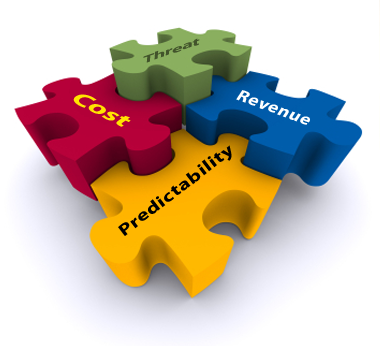
4 Reasons Strategic Buyers Will Pay More
In the M&A world, it’s often said that strategic buyers pay higher valuations than financial buyers. Are they simply irrational buyers? Not necessarily. In many cases, strategic buyers are motivated by different facets of the acquisition and may have different avenues by which they can generate an acceptable ROI from the target. In client interviews with bankers and strategic buyers who are part of the Axial network, we isolated four concrete and logical reasons behind strategic buyers’ ability to pay more.
Revenues
Strategic buyers often have existing customer relationships they want to leverage after acquiring a company. They also want to acquire customers to rapidly grow market share. Acquiring customers one by one or taking them away from installed and entrenched service providers can be hard, sometimes near impossible.
To that end, one of the biggest synergies that companies often seek to generate relates to a one-stop shop strategy. ORACLE might be one of the best known strategic buyers in the technology industry and they have employed this strategy up and down the technology stack, from ERP and CRM, all the way through the programming layer down to the database layer.
Recently on Axial, a strategic buyer operating in the giftware industry was seeking to leverage a massive catalog distribution channel they had developed. They discovered a clothing manufacturer whose product plugged right into their catalog business, creating significant strategic revenue synergies for both the target and the acquirer.
Costs
When a financial buyer acquires a standalone company as part of a “new platform” acquisition strategy, there isn’t an existing business into which they intend to merge that business. As such, all core administrative expenses and resources must remain in place after the change of ownership. Not so with strategic buyers; if a strategic buyer already has a great HR or Admin, Finance, and IT platform, and can merge the products, intellectual property, and other capabilities without duplicating the standalone back-end costs, then they are fundamentally able to pay more.
Let’s use an example to illustrate this: Company A is for sale and generates $60M of revenues and $7M of pre-tax income. If there is a financial change of control for that business that doesn’t entail an integration with a strategic buyer, then all the administrative infrastructure necessary to run the company is still required. Perhaps new ownership can renegotiate contracts and operate more efficiently, but that often leads to marginal changes in profitability. Conversely, Company A is sold to a strategic buyer and, leaving aside any revenue-based improvements, the strategic buyer is capable of eliminating the entire administrative infrastructure. Whereas the financial buyer must model the earnings capability of the business off of $7M of pre-tax income, the strategic buyer can potentially strip out the administrative and IT costs and assume $8M of pre-tax income. Consolidating expenses (including rent, labor, insurance, and other back office functions) can significantly improve profitability, thus allowing the strategic buyer to bid more while still ensuring a successful ROI on the acquisition.
Eliminating Threats & Vulnerabilities
As companies grow large and become more complex to manage, they often become less agile and less able to compete with nimble competitors who have simplified cost structures and newer technologies or processes. Often, it’s preferable for large companies to simply buy small companies versus try to compete with all of them.
Other times, companies have large and highly profitable business models that are entirely threatened by new entrants or paradigm shifts in their market. This happens a lot in technology and technology-enabled markets. Sometimes, strategic buyers will buy companies to simply defend the existing cash-generating business that they currently enjoy. When a company has a profitable and powerful cash-generating business, and those economics are jeopardized by an emerging competitor, sometimes the strategic buyer will pay an enormous premium in order to eliminate the threat. Business owners who want their companies to live and thrive after a sale should be very wary of these potential situations and look for signals that this is the ultimate intent of the strategic buyer. In fact, this is one of the most compelling reasons to sell your company to a financial buyer; they are much less likely to have such multi-faceted, ulterior motives.
Increase Business Predictability
Many businesses are inherently cyclical while others are more stable and, when combined with a cyclical business, can provide a counter-cyclical offset. Cyclical businesses can be huge, like Intel (NYSE: INTC), whose revenues and profits often ebb and flow with their chip production and OEM purchasing cycles. Stable businesses tend to be businesses that offer non-discretionary services, such as health care. Companies with highly cyclical financial performance are punished by Wall Street with lower valuations and lower multiples. One method by which these large corporations counteract their business cyclicality is by acquiring stable businesses that have less overall variability in revenues and profitability.
While it’s often the case that strategic buyers may bid at and ultimately pay a premium for companies, understanding these motivations can help you determine how to optimize your business to leverage these motivations, develop the company to be a more attractive acquisition target for strategic buyers, and prepare for post-acquisition obligations.